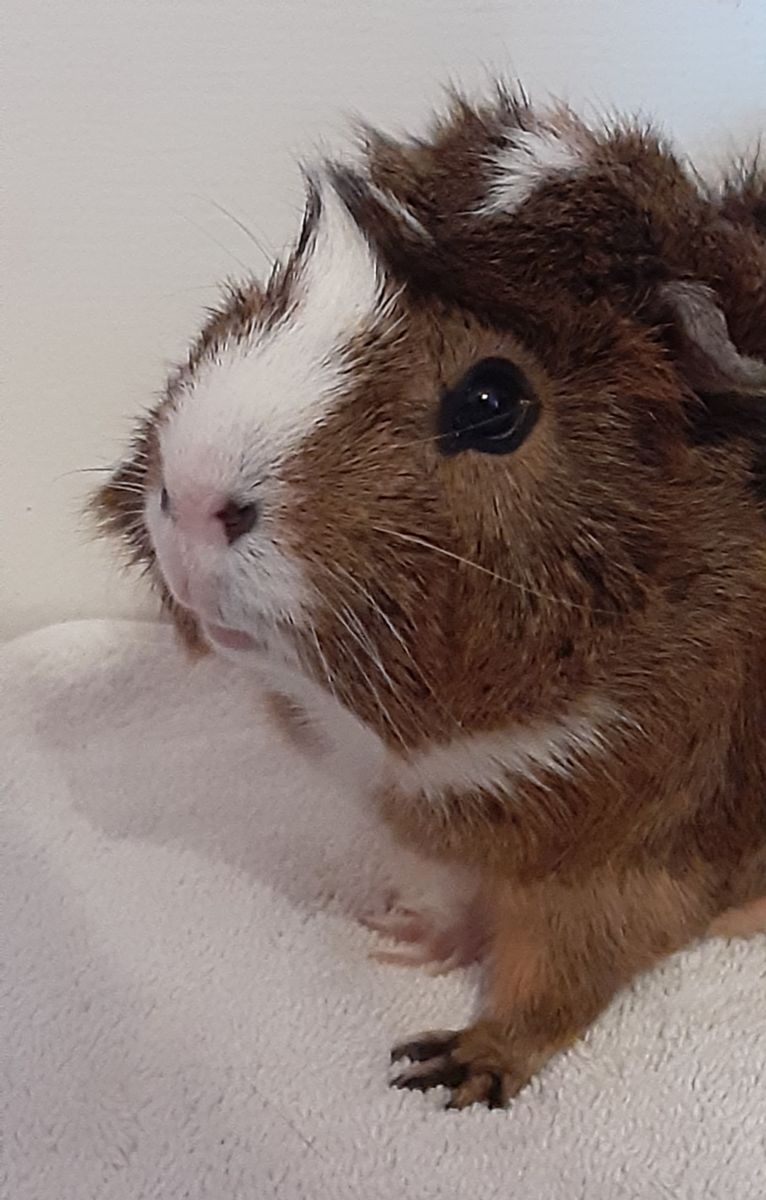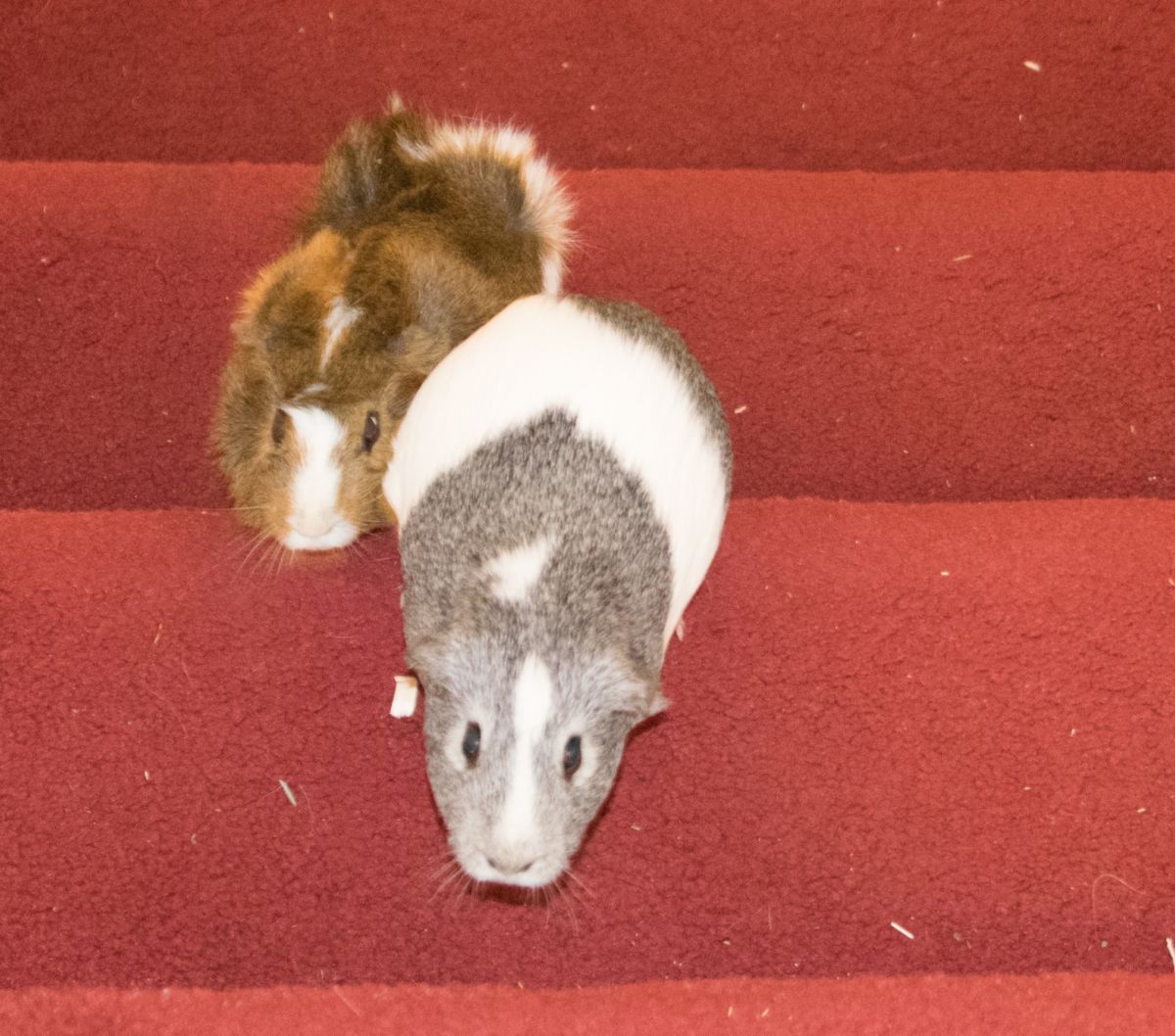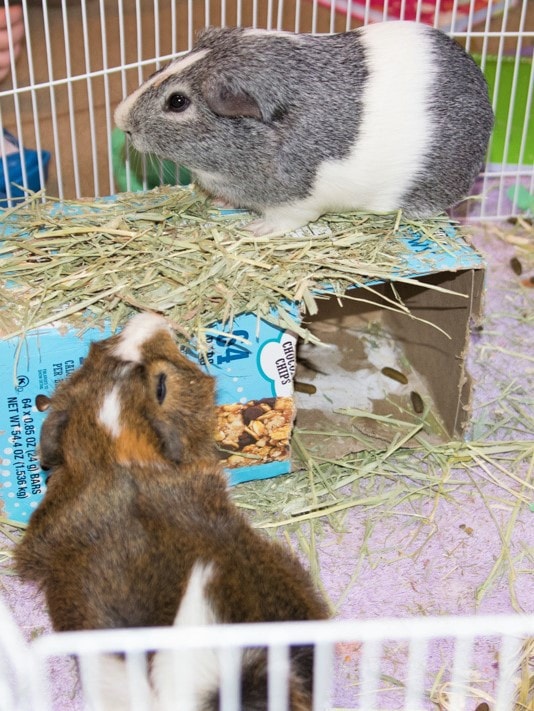Guinea pig bedding can cost a lot, so why not make your own, or use something you already have in the house for this purpose!
We’re going to talk about:
- How to make two types of fleece liners DIY (with or without sewing)
- How to make DIY paper bedding
- Two great alternatives to traditional bedding
- Bedding alternatives you shouldn’t use
Let’s get started!
Fleece Liners
Fleece liners have several pros and cons, just like any type of guinea pig bedding. So, real quickly I’m going to tell you about them.
Pros
Fleece liners are a great guinea pig-safe bedding. It is dust free, which means that your piggies will be a lot less likely to develop respiratory problems!
Also, it is very soft, making it great for their sensitive feet. Guinea pigs also really enjoy to rest their bellies on a soft material!
Fleece liners are available in all different colors, patterns, etc; so you should definitely find the perfect one! Cage liners are also reusable, and save money in the long run!
Cons
You shouldn’t just buy some fleece and throw it in your piggies’ cage, as fleece on its own won’t absorb your guinea pigs’ pee.
Instead, the cage liners should have some kind of absorbent material under or inside of them. You should also spot clean the fleece a few times per week, and wash it regularly.
Also, hay, fur, and bedding often get stuck to the liners, and can be hard to remove. Fleece liners can also be costly up front.
Things to Consider Before Using Fleece
Of course, there are a few things to consider before using fleece in your guinea pigs’ cage.
1–It Will Require Lots of Cleaning and Maintenance
If you use fleece in your guinea pigs’ cage, you will have to clean it more often than you would paper bedding.
Every day (or at least most days), you should spot-clean the cage liners, using a dust pan and brush, or even a vacuum cleaner. You will also need to wash it regularly, usually about once a week.
2–You Will Have to Wash it Several Times Before Use
Before you put the fleece liner in your guinea pig cage, you should wash it a few times beforehand, in order for it to absorb moisture well.
Benefits of Using Fleece
Fleece liners are great, because…
They save money in the long run. If you use wood shavings or paper bedding for your guinea pigs’ cage, you will have to keep buying more whenever it runs out, which can get pretty expensive over time.
However, if you use fleece liners instead, you can keep reusing them for a really long time (the exact time will depend on the kind of liner you use, how well you take care of it, etc).
They produce less waste. With traditional bedding, you will have to throw out lots of bedding. But, if you use fleece you won’t!
They come in many different colors, patterns, styles, etc. Cage liners come in many varieties, and you should definitely find the perfect one for the cage!
They are easier to clean. Although they do require more maintenance than wood shavings or paper bedding, cleaning the fleece liners themselves is easier than cleaning traditional bedding.
They are soft and comfortable. Fleece liners are very soft and more comfortable for your piggies to play and rest on.
They are dust free. Traditional guinea pig bedding often contains some dust, which can irritate your guinea pigs’ respiratory system. However, cage liners are dust free!
How to Prepare the Liners Before Use
Before putting the fleece liners in your guinea pig cage, it is recommended to wash and dry the liners at least three times before putting them in the cage, using a mild detergent.
When washing the cage liners, do not use a fabric softener, as this prevents the liner from absorbing moisture well.
How to Clean Cage Liners
Here is how to clean your cage liners:
Daily (or at Least a Few Times per Week)
You should brush debris (droppings, hay, etc) off of the liner using a dust pan and brush or even a vacuum cleaner, to keep it clean.
Weekly
Once a week, brush and shake debris off of the liners, then wash it using a mild or pet-safe detergent. Remember not to use fabric softener, as it prevents the liner from absorbing as well.
How to Make Fleece Liners (with Sewing)
To make these fleece liners, you will need:
- 2 Fleece blankets
- Washable Waterproof under pads
- Scissors
- Sewing machine or needle and thread
First, spread out 1 fleece blanket. Now, place the waterproof under pads on top of the blanket, with the absorbent side down. Put the 2nd fleece blanket on top.
Next, cut the blanket with a 1/2 or 1 inch border. After that, remove the top blanket and put it off to the side. Sew the under pads and 1 fleece blanket together using a straight stitch.
After sewing, spread out the liner and lay the 2nd fleece blanket on top of it, and sew all the sides together using a straight stitch. Sew all the sides together again if desired.
How to Make Fleece Liners (without Sewing)
You will need:
- 2 fleece blankets (that you can tell apart)
- Washable Waterproof under pads (or mattress topper)
- Pins
- Scissors
- Hemming web
- Iron
- Old cloth
To start, spread out one fleece blanket with the top of it facing down (this will be the absorbent layer, so make sure that you can tell it apart from the other blanket). Next, spread out the under pad (top facing down) on top of the blanket.
Now cut the blanket so that there is a one-inch border around all sides. After that is done, pin (pins will go through the under pad as well) the corners and the center of each of the sides (about one inch away from the edge of the under pad).
Then cut a length of hemming web the same length as the under pad, and put the hemming web underneath the edge of the under pad.
Wet the old cloth (not so wet that it’s dripping, but make sure that it is damp), and spread it over the part of the cage liner that the hemming web is underneath.
Iron over that area, and make sure to hold the iron in place for about 10 seconds, so the hemming web holds the fabric together well. Then go over the area again with the iron.
Now cut the hemming web, put it under the pad, wet and spread out the old cloth over it, and iron the other three sides.
After that is done, remove the pins from the fabric. Lay out the second fleece blanket with the top facing up.
Now put the rest of the cage liner on top of the blanket, making sure that there isn’t any wrinkles and line up the edges. Also, ensure that both fleece blankets are together and the under pad is facing upwards.
Now pin the liner like before, and then cut any excess fleece from the 2nd blanket.
Cut a length of hemming web (same length as the pad) and tuck it in between the 2 fleece blankets, but not underneath the pad. Then use the old (damp) cloth to iron it like before. Only do this step for 3 sides–2 long sides and 1 short side.
Now, remove the pins again, and trim off the excess fleece on the 3 sides (do not cut the hemming web when doing this). After that, stick your hand in between the two fleece blankets and turn the whole liner inside out, and ensure that even the corners are turned inside-out.
Now put hemming web (the width of the pad) along the 4th side, right along the edge of the under pad, and iron it using the wet cloth like before.
Next trim the excess fleece from the last side, being careful as not to cut the hemming web.
Paper Bedding
Of course, paper bedding has pros and cons, too!
Pros
Most paper bedding is guinea pig safe, but you will have to make sure that it is mostly dust free, doesn’t contain scents or chemicals, etc.
Paper bedding is quite absorbent, and is it very soft and comfy for your piggies. Many also control odor well.
Paper bedding also doesn’t require as much cleaning and maintenance as fleece bedding does; you only have spot-clean the cage a few times a week, and fully change the bedding every 1-2 weeks.
Cons
There aren’t too many cons, but here are some cons that I have both heard about and experienced myself:
It often gets costly in the long run. Since you will keep having to buy it again every time you run out, you will often spend more money.
It is messy. If you use bedding, it will most definitely get out of the cage somehow, whether you dropped some bedding on the floor while cleaning the cage, the guinea pigs kick it out, etc.
You will have to throw out lots of bedding.
Benefits of Using Paper Bedding
Here are several benefits of using paper bedding for your guinea pigs:
Many are dust free. Many types of paper bedding are dust free, which is good for your piggy’s respiratory system.
It is absorbent. For the most part, paper bedding is very absorbent, however, if you make your own, you can’t be as sure that it is super absorbent.
It requires less cleaning/maintenance. Compared to some bedding options out there, paper bedding doesn’t need as much cleaning. You should spot-clean it a few times a week, then fully change the bedding every 1-2 weeks.
It is soft and comfortable. Your guinea pigs should really enjoy it because it is soft and comfy!
How to Clean Paper Bedding
Here’s how to clean paper bedding:
Every Few Days
Spot-clean by scooping dirty bedding, then putting in more fresh bedding if needed.
Every 1-2 Weeks
Fully change out all the bedding and put in new, fresh bedding in its place.
How to Make Paper Bedding
To make DIY paper bedding for your guinea pig, you will need:
- A washing machine
- Paper
- An old pillowcase (that you don’t care about anymore)
- Oven
Grab a great big stack of paper, and lightly crumple the paper up and toss it in the pillowcase.
Once the pillowcase is about half full, twist up the end of the pillowcase that doesn’t have bedding in it and then tie it up into a very tight knot. Make sure that the knot is tight (if it is not tight enough and the paper gets in your washing machine, it will wreck the machine).
Now, throw it in the washing machine. Set the wash for a spin cycle with hot water (do not use any detergent, soap, fabric softener etc for this step). Once the wash is done, take out the pillowcase and dump its contents onto one (or more) baking trays.
Now, break the larger clumps into smaller clumps by rubbing and breaking them apart with your hands, so not only will they take less time to dry, but you will also have more bedding to use.
After that, ‘bake’ your paper in the oven set for 215 F (about 100 C).
Check every 20 mins to make sure it is completely dry, if it is dry, you should be able to hold it in your hand and squeeze it without it making any squishing sounds or have water coming out of it.
If the bedding isn’t dry yet put it in the oven again for another 20 mins, until it is done.
You will probably need to make more than one batch of this, so you have enough bedding for the cage.
After that it is done, and you can use it for your guinea pigs!
Alternative Bedding
There are, of course, alternatives to traditional guinea pig bedding.
The two bedding alternatives I will tell you about (these are the only ones I have heard about, too) are:
- Towels, and
- Bath Mats
Let’s learn more about them!
Pros
If you use bath mats or towels as bedding for your guinea pigs, you will save money, as towels and bath mats cost a lot less than most bedding options, and you can reuse them for quite a long time.
They are also dust free, and come in a variety of colors, sometimes patterns, etc. Many bath mats are also very soft and comfortable for your piggies, and towels are kind of soft as well.
Cons
The main con of using towels or bath mats as bedding is that they are not meant for this purpose, and may not be as absorbent as guinea pig bedding made to be used as bedding.
This means that you may need to clean them more often.
Towels As Guinea Pig Bedding
Got some old towels somewhere in your home? If so, you can totally throw them in your guinea pigs’ cage and use them as bedding!
But wait! Before you do this, please keep reading to learn a bit more about using towels as bedding for your piggies.
If you are going to use towels to line your guinea pigs’ cage, it is a good idea to either have two towels and put one on top of the other, or fold the towel in half, to help the towel absorb their pee better.
To clean the towels, what I do is spot-clean the towel (using a small dustpan and brush) every day or every other day, and wash it every 1-2 weeks.
(I don’t clean it too much because the towel is in an area of the cage where the guinea pigs don’t go as much, so there is a good chance you will have to clean it more often than this).
Bath Mats As Guinea Pig Bedding
Although I have never used bath mats as bedding for my guinea pigs, I have heard about and seen different trusted guinea pig owners use bath mats instead of fleece.
As far as cleaning goes, it sounds like you should spot-clean the bath mat daily (the same way you would spot-clean a fleece liner), and wash it at least once a week (more often if needed).
How to Wash the Bath Mats and Towels
Wash the towels or bath mats the same way you would for fleece liners:
Brush and shake debris off. Wash using a mild or pet-safe detergent and hot water. Remember not to use fabric softener.
Unsuitable Guinea Pig Bedding Alternatives
Not all alternative guinea pig bedding is good to use. Do not use the bedding alternatives below.
Cat Litter
Cat litter is a horrible alternative to normal bedding! The litter often contains chemicals in it, which are meant to control odors, but are harmful to your piggies.
The chemicals can cause allergic reactions, skin irritations, and respiratory problems. The texture of the cat litter is also very hard and uncomfortable for your guinea pigs to walk on.
Also, if one of your piggies were to eat the bedding, it could be dangerous!
Newspaper
Newspaper is not absorbent and your guinea pigs will be walking around on wet bedding most of the time, which can be bad for their health.
Paper Towels
Paper towels aren’t a good bedding substitute either. It, like newspaper, is not very absorbent, and it will get wet quickly.
I hope this is helpful!




